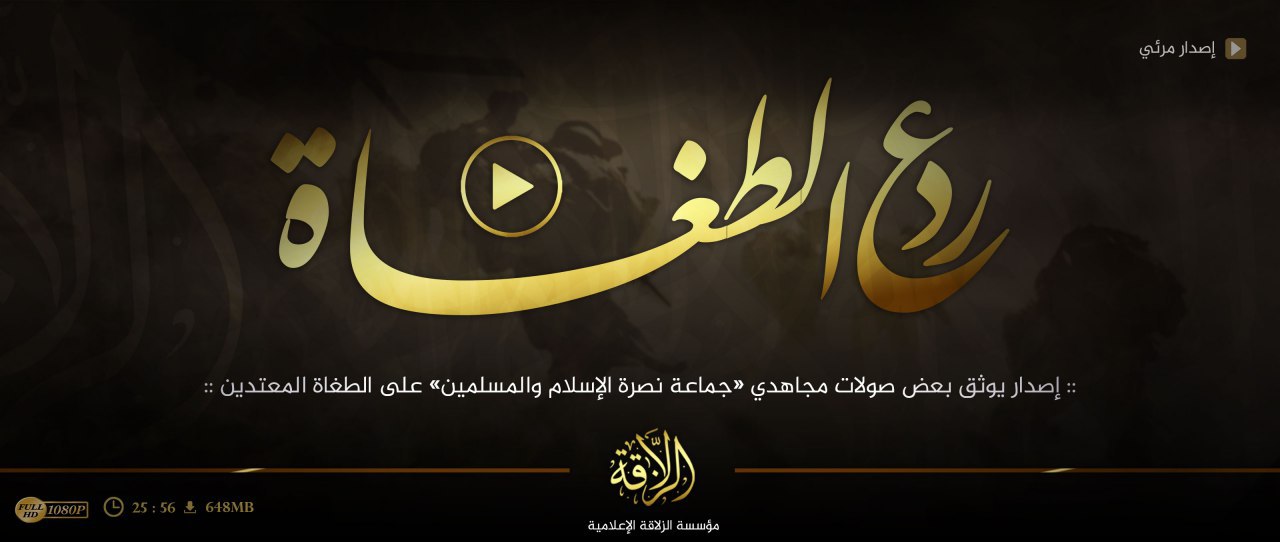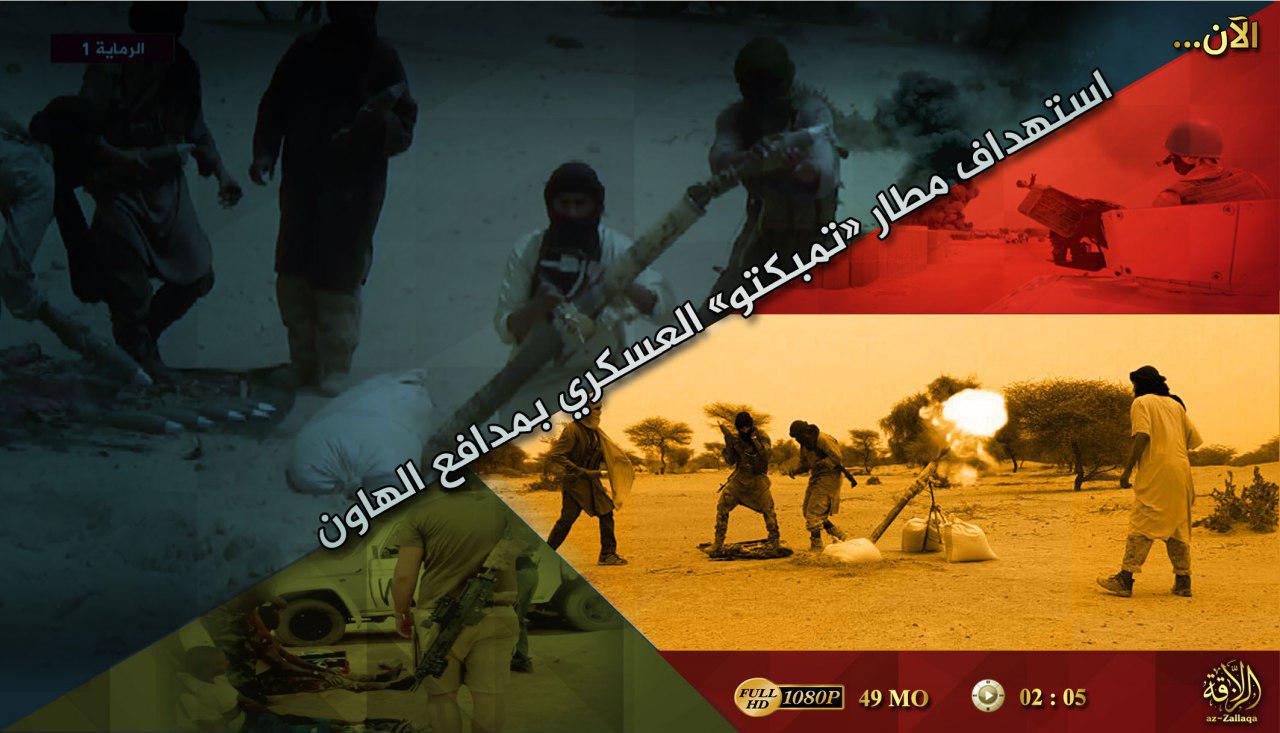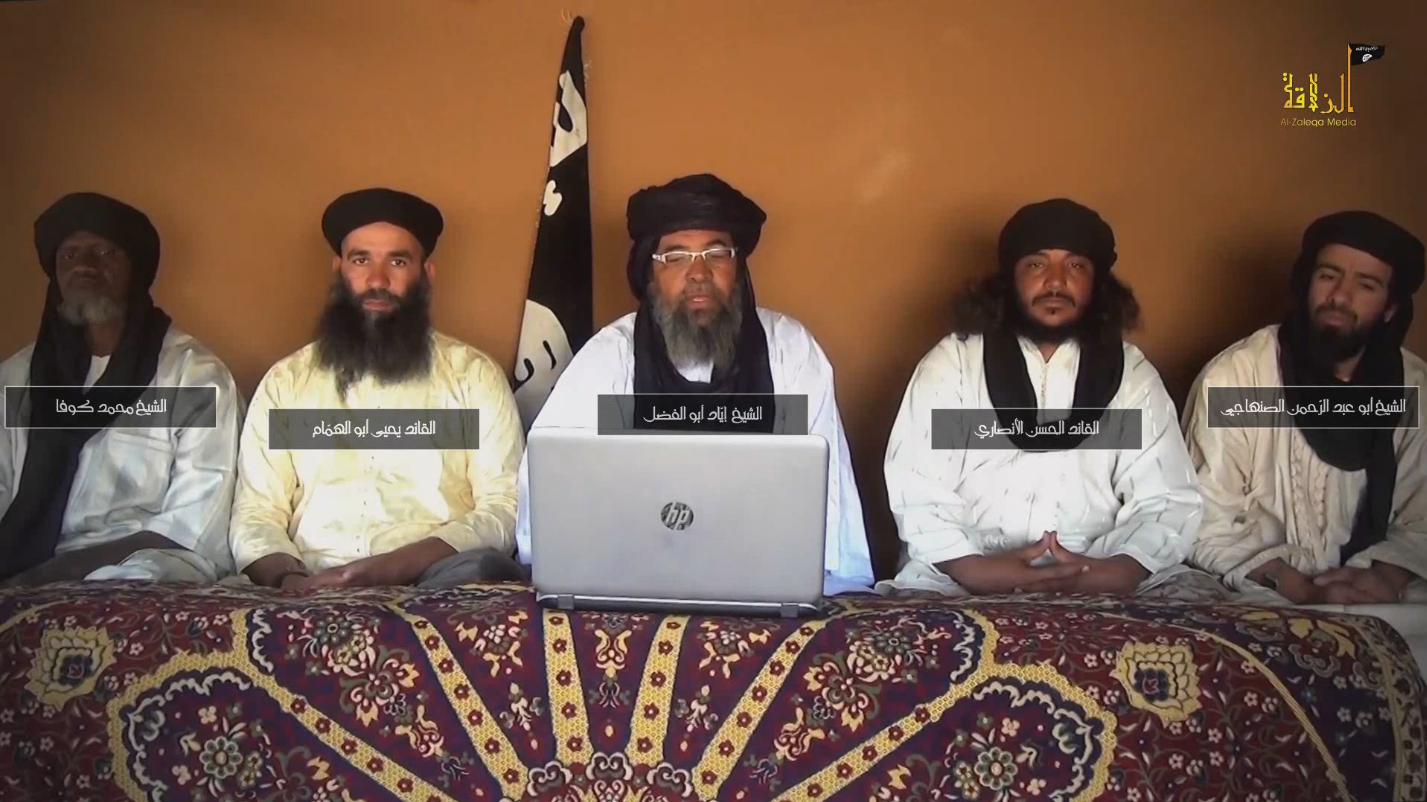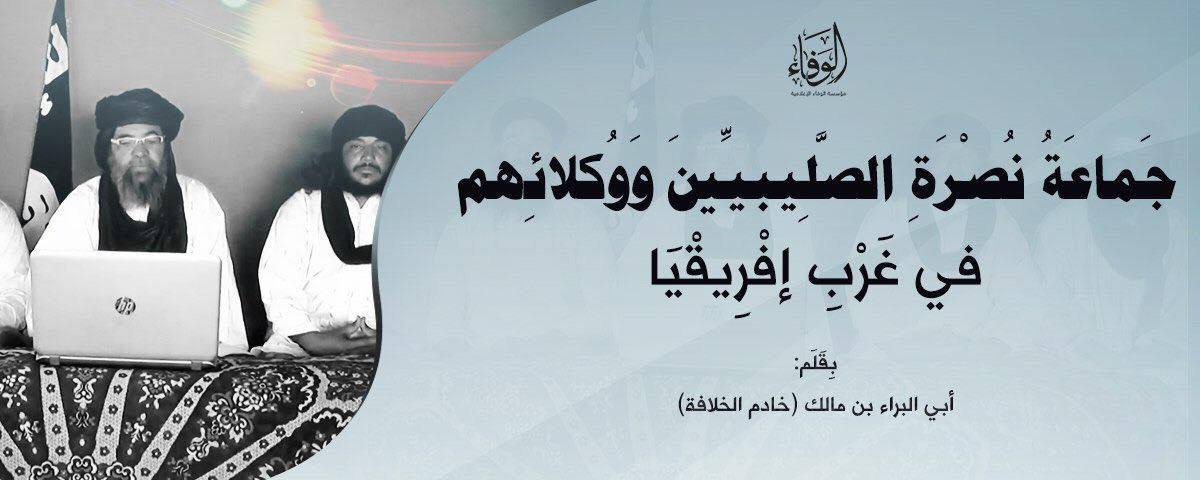
_____________
To inquire about a translation for this video message for a fee email: [email protected]
Category: Jamā’ah Nuṣrat al-Islām Wa-l-Muslimīn
New video message from Jamā’at Nuṣrat al-Islām Wa-l-Muslimīn: "Documenting the Raid of the Mujāhidīn Upon a Checkpoint of the Malian Army"

_____________
To inquire about a translation for this video message for a fee email: [email protected]
New video message from Jamā’at Nuṣrat al-Islām Wa-l-Muslimīn: "Repulsion of the Transgressors"

___________
To inquire about a translation for this video message for a fee email: [email protected]
New statement from Jamā’at Nuṣrat al-Islām Wa-l-Muslimīn: "Denial and Lies of What Has Recently Been Attributed to the Events of the Mujāhidīn"

Click the following link for a safe PDF copy: Jamā’at Nuṣrat al-Islām Wa-l-Muslimīn — Denial and Lies of What Has Recently Been Attributed to the Events of the Mujāhidīn
____________
Source: Telegram
To inquire about a translation for this statement for a fee email: [email protected]
New video message from Jamā’at Nuṣrat al-Islām Wa-l-Muslimīn: "Targeting Timbuktu Military Airport With Mortars"

____________
To inquire about a translation for this video message for a fee email: [email protected]
GUEST POST: Jihadist Groups In The Sahel Region Formalize Merger
As with all guest posts, the opinions expressed below are those of the guest author and they do not necessarily represent the views of this websites administrator and does not at all represent his employer at the Washington Institute for Near East Policy.
Jihadology.net aims to not only provide primary sources for researchers and occasional analysis of them, but also to allow other young and upcoming students as well as established academics or policy researchers to contribute original analysis on issues related to jihadism. If you would like to contribute a piece, please email your idea/post to azelin [at] jihadology [dot] net.
Click here to see an archive of all guest posts.
—
Jihadist Groups In The Sahel Region Formalize Merger
By Héni Nsaibia

Leading figures gathered for the announcement of the merger into Jama’at Nusrat ul-Islam wal-Muslimin (screen capture from the video released by al-Zaleqa Foundation for Media Productions)
In the midst of a faltering peace process in Mali that are characterized by quarrels and cleavages between the Malian government and signatory armed groups, they are increasingly fragmented along ethno-political lines. In contrast, jihadist groups at the core of a regional insurgency display a united front by merging and renewing their oath of allegiance to Al-Qaeda and its leader Aymen Al-Zawahiri, a move that possibly could fuel Islamist militancy in Mali and across the porous borders of neighboring countries.
From rebellion hijacked by Islamists to French intervention and the world’s most dangerous peacekeeping mission
In early 2012, a Tuareg-led rebellion against the Malian government in Bamako swept the north of the country with the aim to seek and achieve independence for a marginalized region largely inhabited by Tuaregs and Arabs. The rebellion was later hijacked by Islamists and consequently catalyzed a military intervention by France and the deployment of a United Nations peacekeeping mission (MINUSMA) – considered the world’s deadliest – in order to stabilize the country. Despite these deployments, the deeply-rooted insurgency shows no signs of being defeated.
Jihadist leaders reunite for a watershed moment
On March 2, a video was released showing the gathering of five leading figures of several jihadist factions in the Sahara-Sahel region. The video constituted the founding statement of a “new group” bringing together the Islamist extremist Al-Qaeda in the Islamic Maghreb‘s (AQIM) Sahara Region, Al-Murabitoun, Ansar Dine, and the Macina Liberation Front (Katiba Macina) movements. Each of the factions were represented by militant commanders who have gained notoriety for spearheading jihadist militancy across the Sahel. Al-Qaeda’s North African franchise AQIM was represented by the Emir of its Sahara Branch, namely Djamel Okacha (Yahya Abu al-Hammam) and Abu ‘Abd al-Rahman al-Sanhaji who is responsible for the movement’s judicial affairs. Al-Murabitoun who have conducted several high-profile terrorist attacks across North and West Africa, led by the infamous militant commander Mokhtar Belmokhtar whose whereabouts and fate remains unknown, was represented by the group’s deputy commander Mohamed Ould Nouini (al-Hassan al-Ansari). Ansar Dine, Al-Qaeda’s (AQ) mainly Tuareg local affiliate was represented by its Emir Iyad Ag Ghaly (Abu al-Fadhl). Lastly, the Macina Liberation Front, a mainly Fulani Islamist group part of Ansar Dine and active in central Mali, represented by its Emir Mohamed Koufa. Together, the militant leaders proclaimed the watershed announcement of a united group, which has assumed the moniker of “Jama’at Nusrat ul-Islam wal-Muslimeen” translated as “Group for the Support of Islam and Muslims” (JNIM).
Anything more than just a structural reorganization?
Despite publicising the alliance and the founding of this new group, it is important to note that the aforementioned factions already enjoyed close operational linkages on the battlefield, which has drawn attention to both the timing and purpose of the merger. So where lies the strategic importance in the formalization of an already existing nucleus? The first explanation for the announcement may be to debunk unsubstantiated media speculation about splits in the ranks of the jihadists, or that al-Qaeda’s Sahel based affiliate groups were seeking to switch allegiance to the Islamic State (ISIS). Secondly, the designation of Iyad Ag Ghaly as the Emir of this alliance further highlights the importance of ethno-political dynamics that are fueling Al-Qaeda’s ascendency in the Sahel. Ag Ghaly’s influence in the mountainous region of Adrar des Ifoghas has been important for AQIM’s implantation in the region where the nobleman and long-serving militant commander has used his wide-reaching familial linkages, and the Islamisization of Tuareg separatism, to secure a steady stream of recruits for his political and religious aspirations. Thirdly, it gives an injection to invigorate the insurgency in the Sahel and also puts a stronger imprint on the region within the global map of jihad.
Since the formation of Ag Ghaly’s Ansar Dine in 2012, the movement has shared a mutually beneficial relationship with AQIM. Following France’s Operation Serval military intervention in Mali, several AQIM cells were reportedly rendered defunct by broad based counterterrorism operations; those that remained were reported to have been provided sanctuary by Ansar Dine. In Mali’s northernmost Kidal administrative division, AQIM had three active katibas or brigades, Al-Ansar, Youssef Ibn Tachfin, and Tariq Ibn Ziyad, which is believed to have been entirely assimilated into the Ansar Dine network. Evidence of this lies in the fact that the region in which these factions operated in – saw militancy which was almost exclusively claimed by Ansar Dine for the past three years, the result of a transient phase beginning with the French intervention, and the subsequent elimination of commanders and decimation of the AQIM brigades active in the area. The restructuring of the weakened AQIM factions, and their assimilation into more powerful groups amid intensive counterterrorism operations, may also explain the dynamics that precipitated the formation of Jama’at Nusrat ul-Islam wal-Muslimeen under the unifying Quranic slogan of “One banner, one group, one emir”.
“And hold firmly to the rope of Allah all together and do not become divided” (Surah Al-‘Imran 3:103)
The message of unity is also articulated with reference to al-Sham – namely the Levant Region of the Middle East – and the alliances created by the formation of the region’s Al-Qaeda proxies of Jabhat Fatah al-Sham and Hay’at Tahrir al-Sham, this despite the articulated intention to “cut ties” with Al-Qaeda by the creation of these alliances. Symbolically, Iyad Ag Ghaly also pays tribute to a long list of deceased al-Qaeda ideologues and commanders. In this regard, there is a strong pro-AQ message, thus cementing its ties with the parent organization Al-Qaeda. Although, there are exceptions, Abu Mus’ab al-Zarqawi and Abu ‘Anas al-Shami both emblematic figures within Al-Qaeda in Iraq, at the same time, precursors who laid the foundation for what was to become the Islamic State. Both held in high esteem by ISIS followers and frequently paid tribute. Al-Shami being the mentor of Taha Falaha more commonly known as Abu Muhammad al-Adnani, the most prominent Islamic State commander. Falaha pledged allegiance to al-Zarqawi back in 2002. As an heir of al-Shami’s and al-Zarqawi’s legacy, their violent doctrine and entrusted by al-Zarqawi, Falaha rose to the top in the Islamic State organization. Falaha was killed in a US airstrike near al-Bab in northern Syria on August 30, 2016. Hence, a subtle indication that AQIM as part of a wider Al-Qaeda strategy is preparing for a post-Islamic State era by flirting with ISIS followers. Although, not without reservations, Iyad Ag Ghaly empasizes in his speech the importance to avoid extremism (ghulu’) and the priority to adhere to the unity of the Islamic Nation (Ummah), Ag Ghaly also
New release from Abū al-Barā' Bin Mālik: "The Support Group of the Crusaders and Their Agents in West Africa"

Click the following link for a safe PDF copy: Abū al-Barā’ Bin Mālik — The Support Group of the Crusaders and Their Agents in West Africa
____________
To inquire about a translation for this release for a fee email: [email protected]
New statement from al-Qā’idah’s General Command: "Support and Blessing for Jamā'at Nuṣrat al-Islām Wa-l-Muslimīn"

Click the following link for a safe PDF copy: al-Qā’idah’s General Command — Support and Blessing for Jamā’at Nuṣrat al-Islām Wa-l-Muslimīn
_____________
To inquire about a translation for this statement for a fee email: [email protected]
New video message from Jamā'ah Nuṣrat al-Islām Wa-l-Muslimīn: "Founding Statement"

____________
To inquire about a translation for this video message for a fee email: [email protected]
